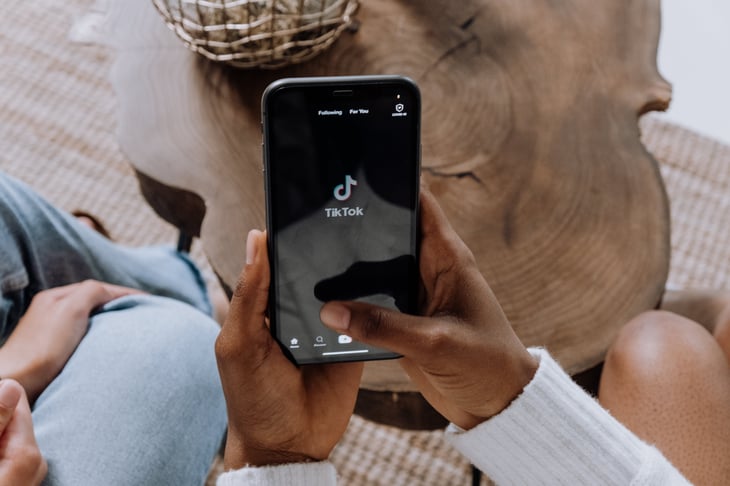4 Things Going Viral on TikTok Taught Me About PR

If you’ve been on TikTok or Instagram Reels for the last year or so, you may be familiar with the viral trend of pet owners not quite petting their pets, as in this video:
@therealcooper Watch till the end ☺️☺️#PlayBall #dogsoftiktok #davidstesla
♬ dont pet challenge - The Real Cooper
Or maybe you’ve seen this video before:
@therealcooper Sorry we’ve been MIA- was busy marrying off one of my best friends and making this epic TikTok! #princessdiarieschallenge @lucyyyyyyy_27 @takco9
♬ original sound - CocoDevile
Why am I sharing these on a Propllr blog post?
The first is a video I made with my 10-year-old dog Cooper while waiting for my partner to finish his shower so we could leave the house. It’s been viewed more than three million times and has been used by more than 151,000 other people to create their own videos that have also generated millions of views.
The second is a video I created at my friend’s wedding, and it has more than 4.4 million views on TikTok and thousands of shares on Instagram.
Both are examples of content I created that went viral.
Here’s what that experience taught me about public relations for startups.
1: Going Viral Won’t Solve All Your Problems
There isn’t an official definition of “going viral.” But when a piece of content (video, news article, tweet, blog post) gets a lot of engagement in a short time – especially relative to the other content a person or startup publishes – it’s fair to say that it’s viral.
After I went viral (twice), my day-to-day life did not change much.
No news outlets were knocking at my door, and I didn’t suddenly have so much income from social media that it made sense to quit my day job [editor’s note: phew!].
But things did change a little:
- Cooper’s TikTok page amassed more than 55,000 followers.
- Brands have reached out to send us free dog products.
- I’ve earned enough from ad money that I’ll have to do taxes for my dog next year. (I never thought I’d be typing a sentence like that.)
In other words, going viral set me up for opportunities that I wouldn’t have otherwise had. But it’s still up to me to make the most of those opportunities.

My little tax burden
The same is true for startups. If your content goes viral, you’ll probably get a big jolt of attention. But the internet has a short attention span, which means the jolt will not last long – unless you’re savvy about leveraging that attention into additional opportunities.
One example we’ve seen: a viral Twitter thread drew the attention of a magazine editor, who solicited an article on the topic the thread addressed. The article got the Twitter user in front of an even larger audience – but he had to invest the time in actually writing it (and fast!) to enjoy that benefit.
2: Going Viral Isn't a Viable Strategy (But You Should Still Optimize for It)
A successful viral post can be an excellent asset for startups. Besides leading to other opportunities, it can boost visibility and awareness of your startup.
But you can’t go viral strategically. There’s just too much that’s outside your control, including the algorithms that drive social media and search results, the way people feel the day your content goes live, and the larger news cycle.
On the flip side, you also can’t go viral if you don’t publish any content, and there are things you can do to make it easier for your content to go viral. Specifically, your content is much more likely to go viral if it’s…
- Shareable: A news article featuring your startup is nice, but it’s not that shareable. A social media post that features a great image from the piece and a key quote, though, is. Making sure your content is easy to share is essential if you want a shot at going viral.
- Easy to understand: If you want your content to be popular with a general audience, you can’t use industry jargon. Your audience will become disengaged as soon as they see a word or phrase that they don’t understand, even if the rest of the piece would be valuable for them. Whatever type of content you’re putting out, spend time making sure it’s easily comprehensible to a busy online audience. This might mean investing in media training before talking to reporters or having a professional writer draft your tweets.
- Consistent: Sometimes, content goes viral because it’s posted at the right time of day or within the right news cycle. However, there’s no good way of predicting what the “right time” is. It’s more of a numbers game. You just have to keep trying things and see what works.
For perspective, I’ve created over 100 videos for Cooper’s TikTok account, each one carefully crafted with the potential to go viral. So far, only two of them have.
3: Virality Doesn’t Equal Brand Awareness
There are two parts to this reality.
The first part: I started this piece highlighting two viral videos I've made, each with over three million views… but there’s a good chance you hadn’t seen either of them before reading this post. And that's the reality of viral content: even if your content goes viral, there’s no guarantee that your target audience will see it.
The second part: Even if your target audience does see your viral content, there’s no guarantee that they’ll associate it with your brand. Think about the last viral content you engaged with on social media. Do you remember who published it? Unless your viral content is specifically about your brand, the odds that your audience will connect the two are slim.
Don’t get me wrong, it’s nice to have a viral video, but it’s not necessary for growth or success. And it certainly doesn’t guarantee either.
Here’s the other side of the coin: there are lots of brands and influencers that never go viral. Instead, they focus on consistently creating and publishing high-quality content that resonates with their followers.
The key to their success is their consistency – and that’s an important lesson for startups: Even if you never go viral, it’s important to remember that each piece of content – blog post, media placement, social post – will move the needle, if only a little bit.
4: Nurturing the Content Is Just as Important as Creating the Content
Every piece of content moves the needle, but the way you promote it can help it move the needle more.
Take my viral videos as an example. Each of them has gone through waves of popularity. When a famous Spanish influencer shared my video two months after I posted it, it got another boost in views. And when LADbible shared my video on its social media pages almost six months after I posted it on TikTok, it became more popular on Instagram.
You can’t control whether others will share your content, but you can nurture it after its original publication. In fact, that ongoing nurturing is key to extending your content’s lifetime value.
Whenever I see that a video is starting to get traction, I ask all of my friends to share it with their networks. I also make sure to engage with as many comments as I can, which draws more visibility to the video and turns people who may have just stumbled upon the video into followers.
Startups can do the same thing, though nurturing may look different for a blog post or media placement than for a TikTok video.
For example, you might…
- Share a successful blog post with a reporter you’re pitching.
- Have a salesperson include a link to a recent media placement in their email signature.
- Include the logo from a recent award win on your homepage.
In fact, we wrote a whole ebook about getting the most out of your PR wins – check it out!
For Best Results, Focus on the Who and the Why
I’ve thoroughly enjoyed the experience of seeing strangers on the internet tell me they would die for my dog and getting texts from my friends saying that someone sent them one of my videos.
But my goal from the beginning of this experience was to create quality, funny videos that I would like to share with some family and friends. My target audience was really clear to me and really small; I had less than a thousand followers when my first video went viral.
Having a lot of followers is nice, but it means nothing if you’re not making content that they like. In fact, the number of followers your page has is becoming less and less relevant as social algorithms develop to be more content-focused (that is, to prioritize viral content over the content of people you follow).
Startups can find success taking a similar approach: know exactly who you’re creating content for, then consistently publish or contribute to content you know will make their lives better. With a little luck thrown in the mix, you may go viral. But even if you don’t, you’ll still be improving the relationships that matter most to your startup.







